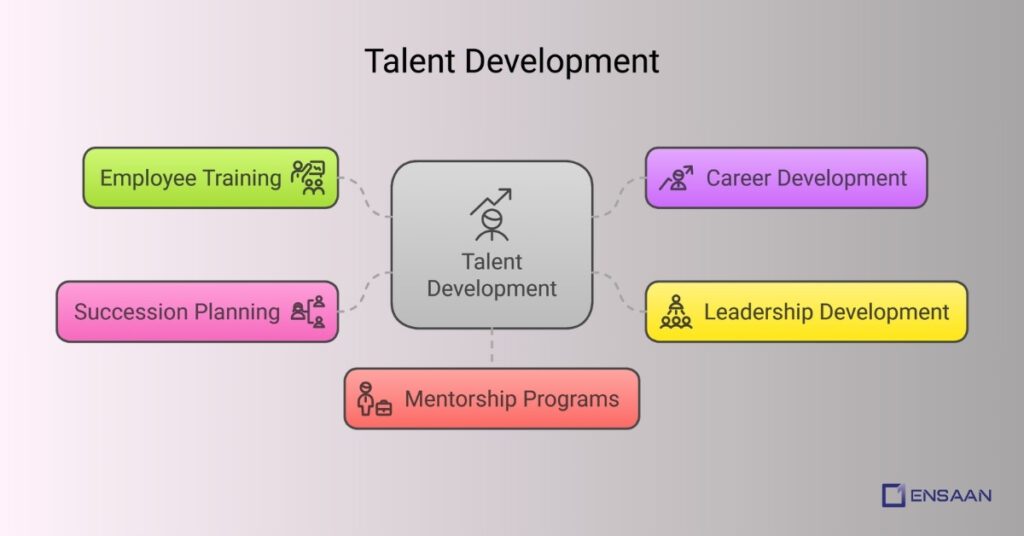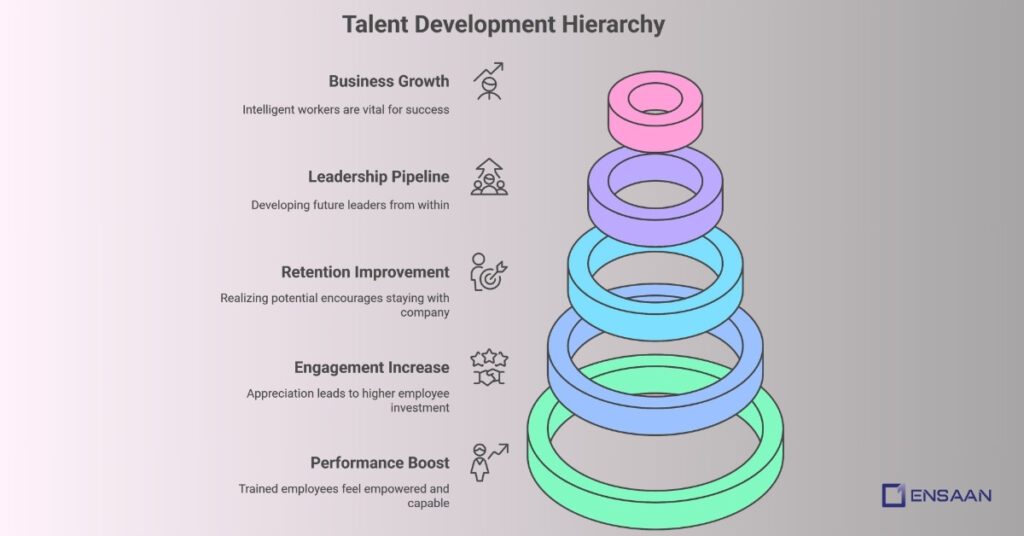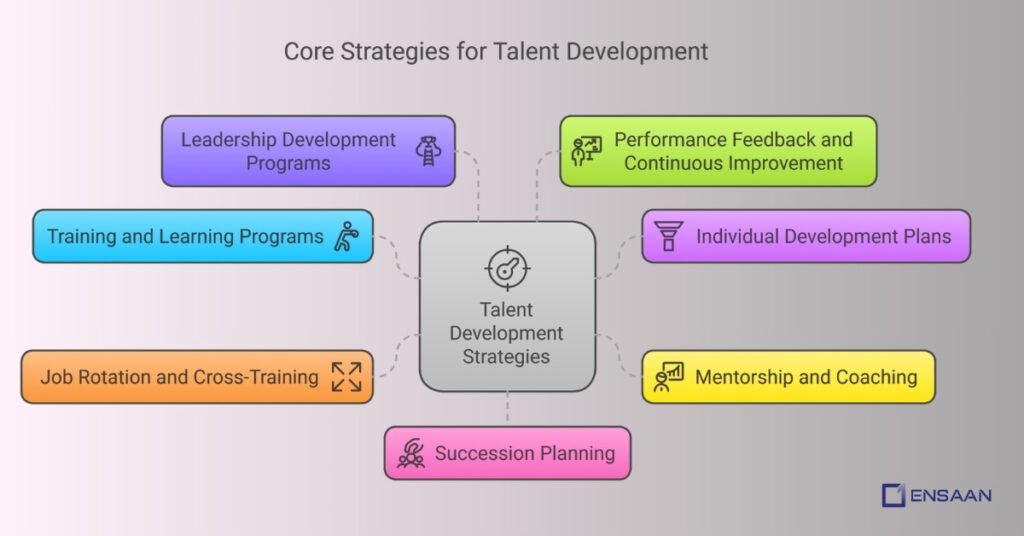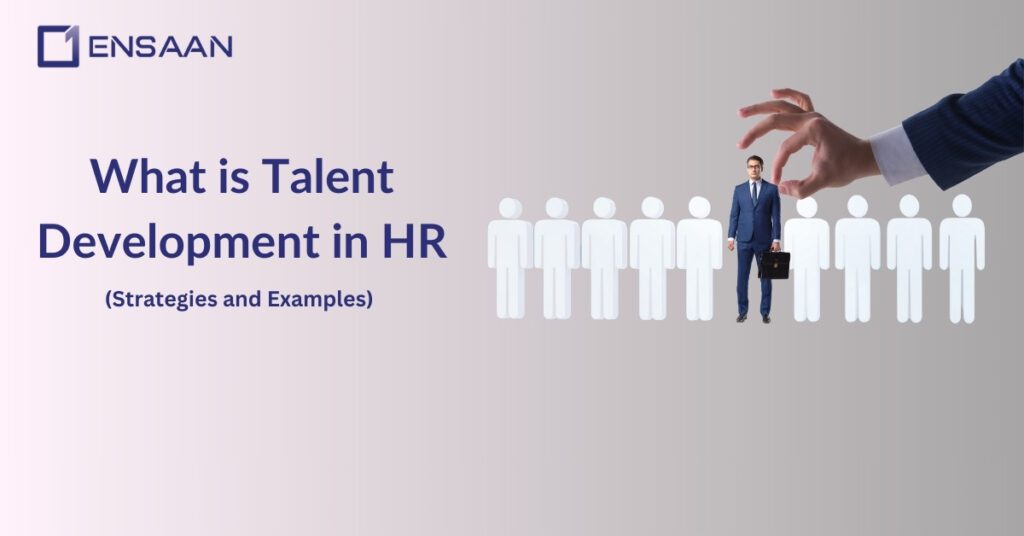In today busy workplaces, a company biggest strength is its people.
Hiring great employees is important, but what really makes a difference is helping them grow, learn, and stay. That’s what talent development is all about.
Want to know how successful companies help employees learn new skills, grow in their careers, and perform better while also making the company stronger?
This blog post discusses what talent development in HR really means, why it is necessary, and some proven strategies and examples that can make this work effectively.
Table of contents
- What is Talent Development?
- Why Talent Development Matters?
- Core Strategies for Talent Development
- Creating a Talent Development Culture
- Real-Life Examples of Talent Development
- How to Start Talent Development in Your Organization?
- Challenges in Talent Development (and How to Overcome Them)
- Conclusion
- FAQ

What is Talent Development?

Talent Development (TD) is an area of HR which specializes in improving employees’ knowledge, abilities and skills so they can advance in their current roles while simultaneously preparing themselves for future ones.
It’s not just about training it’s about helping people reach their full potential at work.
It includes:
- Employee training
- Career development
- Leadership development
- Succession planning
- Mentorship programs
In short, it’s everything a company does to build a better team for tomorrow, starting today.
As companies increasingly prioritize employee growth and retention, many are turning to advanced learning platforms to support these goals.
One standout solution is Cornerstone OnDemand’s Talent Development product, which helps organizations build skills, track progress, and drive meaningful career development at scale.
Why Talent Development Matters?

Here is why investing in talent development is beneficial to both employees and employers:
- Boosts Employee Performance: Trained employees tend to feel more empowered and capable.
- Increases Employee Engagement: People tend to become more invested in companies who show them appreciation.
- Improves Retention: Employees who feel that their potential can be realized are more likely to stay with an organization.
- Builds Leadership Pipeline: By developing leadership talent from within, this initiative seeks to equip future leaders.
- Drives Business Growth: Employing intelligent, capable workers is vital for business.
Core Strategies for Talent Development

Let’s discuss some practical strategies companies employ to enhance employee growth:
1. Training and Learning Programs
Talent development encompasses multiple components. They may include:
- Onboarding Training for new hires
- Technical Training for job-specific skills
- Soft Skills Training like communication, teamwork, leadership
- E-learning Platforms for flexible, on-demand learning
Example:
A tech company like Google offers thousands of internal courses, covering everything from coding to public speaking, helping employees sharpen skills or learn entirely new ones.
2. Individual Development Plans (IDPs)
An IDP (Individual Development Plan) is an individual-created roadmap designed to assist employees with their career development. It should contain details about:
- Skills they want to improve
- New skills they want to learn
- Career goals
- A timeline and resources to help them achieve these goals
Example:
At IBM, employees sit down with their managers twice a year to review their development plans and set new learning goals. It keeps growth consistent and measurable.
3. Mentorship and Coaching
People learn best with guidance. Mentorship programs pair employees with more experienced professionals who help them expand. Coaching addresses specific goals or performance improvements.
Example:
At General Electric (GE), high-potential employees are assigned mentors from senior leadership to fast-track their development and prepare them for top roles.
4. Job Rotation and Cross-Training
As employees explore various roles or departments, it allows them to gain new perspectives, expand skills, and discover untapped potential.
Example:
Unilever runs a rotational graduate program where fresh hires work across different departments to understand the full business before choosing their path.
5. Leadership Development Programs
Finding and training future leaders are essential components of talent development. Leadership programs may include:
- Workshops and seminars
- Leadership coaching
- Stretch assignments (challenging projects)
- Exposure to senior leadership
Example:
At PepsiCo, the Leadership Development Program includes international assignments and intensive learning sessions, helping prepare top talent for executive roles.
6. Performance Feedback and Continuous Improvement
Regular feedback helps employees understand where they stand and what to improve. Modern companies use ongoing feedback instead of just yearly reviews.
Example:
Adobe replaced traditional performance reviews with “Check-ins”—regular one-on-one conversations between managers and employees. It improved engagement and productivity.
7. Succession Planning
Succession planning refers to the practice of identifying and training internal candidates to fill key roles when they become vacant – like having someone on standby waiting their turn when a vacancy occurs.
Example:
At Amazon, leaders are always asked: “Who’s ready to take your job tomorrow?” That’s how seriously they take succession planning.
Creating a Talent Development Culture
It’s not just about the programs it’s about building a culture that supports learning and growth. Here’s how you can do that:
- Encourage Curiosity: Let people explore new skills and ideas without fear of failure.
- Celebrate Learning: Recognize those who complete training, get certifications, or take initiative.
- Make Learning Accessible: Use digital tools and mobile learning platforms.
- Lead by Example: Leaders should also take part in development programs.
When development becomes part of the DNA of a company, magic happens. People grow, businesses thrive, and turnover drops.
Real-Life Examples of Talent Development
Let’s look at a few standout companies that excel in talent development:
1. Google
Google is known for its “20% time” concept employees are encouraged to spend 20% of their time on projects outside of their main role.
This freedom leads to innovation (Gmail was born this way) and helps employees grow skills they care about.
2. AT&T
AT&T invested $1 billion in a program called “Future Ready” to reskill their workforce for emerging technologies.
It includes online courses, certifications, and learning pathways aligned with the future of work.
3. LinkedIn
LinkedIn offers internal learning paths and encourages employees to use LinkedIn Learning.
They even created a culture where “learning in the flow of work” is the norm.
4. Amazon
Amazon’s “Career Choice” program pays up to 95% of tuition for employees to take courses in high-demand fields even if it’s outside Amazon. That’s a bold commitment to talent development.
How to Start Talent Development in Your Organization?

If you’re part of a growing company or an HR team that’s ready to build a talent development strategy, start with these steps:
Step 1: Assess Needs
Find out where skill gaps exist in your team or organization.
Step 2: Set Goals
Decide what success looks like. Is it higher retention? Better performance? More internal promotions?
Step 3: Design Programs
Based on your goals, choose the right mix of training, mentoring, coaching, and development plans.
Step 4: Use Technology
Leverage platforms like LMS (Learning Management Systems), mobile learning apps, or AI-powered tools to scale your efforts.
Step 5: Measure and Improve
Track participation, completion rates, employee feedback, and performance outcomes to keep improving the programs.
Challenges in Talent Development (and How to Overcome Them)
Like anything worth doing, talent development has its hurdles:
| Challenge | Solution |
| Lack of Time | Offer flexible, bite-sized learning |
| Low Engagement | Make learning relevant and fun |
| Budget Constraints | Use free or low-cost digital tools |
| Measuring ROI | Use data to link learning to performance improvements |
The key is to start small, iterate, and keep the momentum going.

Conclusion
Talent development is not just a trendy HR term it’s a smart, strategic investment in your people and your business.
Whether it’s helping an intern grow into a manager, or reskilling your workforce for the future, the results can be powerful.
Companies that embrace talent development create loyal, engaged, and skilled employees who are ready to take on whatever the future brings.
So, if you’re a business owner, HR pro, or team leader now the time to ask:
“How am I helping my people grow today, so they can lead tomorrow?”
FAQ
Talent development means helping employees grow their skills and become better at their jobs.
No, it’s not the same. HR does many things like hiring and managing people. Talent development is one part of HR that focuses on training and growth.
– Identify the skills people need
– Plan how to build those skills
– Train and support employees
– Review progress and give feedback
Talent helps a company grow, solve problems, and stay ahead of others.
Very important! It keeps employees happy, improves work, and helps the company succeed.








